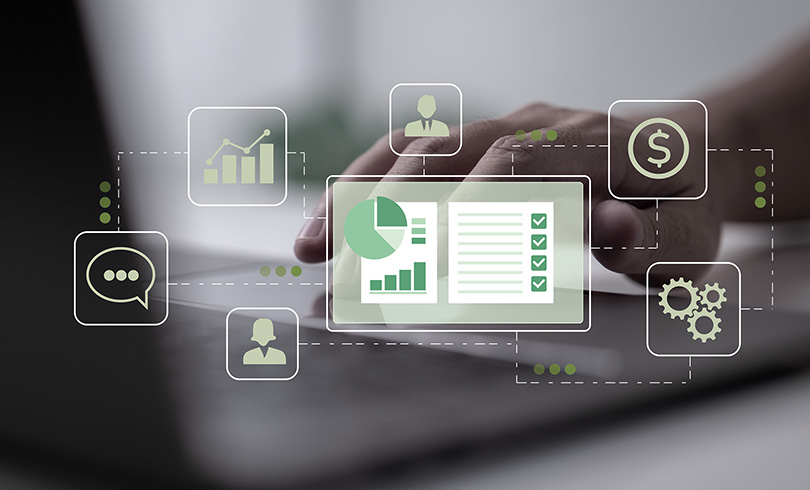10 Ways ERP Integration Boosts Accounts Receivable Management
-
29 Jan, 2024
-
6 min read

It's common knowledge that ERP (Enterprise Resource Planning) Systems provide a single source of truth and a deeper understanding of your company's costs and revenue. It's also known that ERP systems offer accounts receivable (AR) functionality, including producing customer invoices, payment processing, and collections.
But for a while, it was less well-known that integrating AR management software into an ERP system offers more benefits to AR processes than simply an ERP alone. However, with the AR automation market set to reach $4 billion by 2025, word has gotten out. For companies of all sizes, Accounts Receivable (AR) functions perform optimally when they share a common dataset and seamlessly integrate with business processes via integration with an ERP system.
In case you're new to the journey, we'll be exploring ten reasons why companies are integrating an AR automation solution to enhance the efficiency of their company's ERP system.
The ten ways ERP integration takes AR to the next level
1. Enhanced collaboration across teams
When AR is integrated into the ERP system, it centralizes financial data, allowing different teams (like sales, finance, and accounts receivable) to access and work with the same information while no longer having to work within the limitations of ERP licensing restrictions. This shared visibility ensures everyone's working with the same data, providing a cross-functional approach.
Read more about the benefits of integrating AR automation into your ERP system: ERP for finance: Beyond your ERP systems.
2. Compliance, risk management, and scalability
As mentioned, integrating the AR function into an ERP system centralizes a company's financial data. Similarly, it also offers recordkeeping and archival benefits.
By centralizing a company's financial data, businesses can easily access and store financial records, reducing the risk of lost or misplaced documents. This data also improves compliance and risk management by automating manual AR tasks and increasing visibility into invoicing.
3. Streamlined workflows across departments
AR processes, such as order-to-cash, become more efficient as information flows smoothly from one department to another without manual intervention or redundant data entry - and when data flows, cash flows.
Research conducted by PYMNTS reveals that 87% of companies with automated accounts receivable (AR) operations are experiencing quicker processing times.
4. Automated reminders, follow-ups, and dunning management
Integration allows automatic scheduling and sending of payment reminders to customers, reducing the likelihood of late payments. By consolidating customer data stored in the ERP systems, AR software can prioritize follow-ups based on payment history and customer value.
5. Highlight the exception and automate the rule
AR automation software excels at exception handling by streamlining processes, improving efficiency, and reducing manual errors. The integrated systems monitor accounts receivable data and identify exceptions automatically, flagging values that fall outside normal parameters or deviate from established rules and algorithms.
That means AR teams now have the tools for early detection, timely intervention, and creating and managing exception-handling workflows. Additionally, by highlighting the exception and automating the rule, AR teams can apply their expertise to more intentional tasks to improve cash flow.
6. Improved self-service customer portals
With AR integrated into ERP, self-service portals for customers have become feature-rich. Customers can access account information, view invoices and supporting documentation, and track their payment history on demand.
7. Real-time financial visibility and predictive analytics
Companies are also analyzing customer interaction data from the self-service portal. These analytics reveal insights into customer behavior, preferences, and pain points - putting customers first in the accounts receivable experience.
8. Enhanced reporting, data analysis, and forecasting
ERP and AR integration provides a single source of truth for financial data, eliminating data silos and discrepancies that can hinder accurate reporting.
The symmetry of financial information enhances reporting, data analysis, and forecasting by streamlining data sharing, automating processes, and improving team collaboration.
9. Automated payment processing and enhanced cash flow management
ERP and AR integration can significantly enhance cash flow management by automating payment processing and streamlining AR workflows. That's because the integration eliminates the need for manual data entry and payment processing, reducing the time it takes to collect customer payments.
10. The impact of AR automation on Days Sales Outstanding (DSO)
A study reported that 62% of firms that deployed AR automation saw an improvement in their DSO. While the specific reduction in DSO will depend on the company and the extent of integration and automation, integrating ERP and AR systems generally leads to a significant improvement in the DSO metric.
For more on reducing DSO and improving your accounts receivable, visit System1A's ultimate guide.
From Data to Decision: Enhancing ERP Efficiency with System1A
System1A integrates with major ERP systems, focusing on extracting accounts receivable data for efficient processing and reporting.
How does System1A integrate with ERP Systems?
System1A connects directly with a business's ERP system. This connection allows System1A to extract or capture all accounts receivable data entered into the ERP or accounting system.
The system then regenerates documents onto its platform, taking data directly from your ERP and recreating it with the flexibility to customize and add additional elements, such as your company logo.
System1A's data extraction tool has read-only access to your business's ERP system, enabling it to read information for use in System1A without being able to write or manipulate any ERP data.
What ERP Systems does System1A support?
System1A's interaction with each ERP is unique. We're continuously expanding our support for more ERPs and developing specific capabilities for each ERP system.
How long does it take to implement?
Integrating System1A into your ERP System takes under 45 minutes. You can be set up and running in under an hour with live data. Ready to see a quick demo?
But for a while, it was less well-known that integrating AR management software into an ERP system offers more benefits to AR processes than simply an ERP alone. However, with the AR automation market set to reach $4 billion by 2025, word has gotten out. For companies of all sizes, Accounts Receivable (AR) functions perform optimally when they share a common dataset and seamlessly integrate with business processes via integration with an ERP system.
In case you're new to the journey, we'll be exploring ten reasons why companies are integrating an AR automation solution to enhance the efficiency of their company's ERP system.
The ten ways ERP integration takes AR to the next level
1. Enhanced collaboration across teams
When AR is integrated into the ERP system, it centralizes financial data, allowing different teams (like sales, finance, and accounts receivable) to access and work with the same information while no longer having to work within the limitations of ERP licensing restrictions. This shared visibility ensures everyone's working with the same data, providing a cross-functional approach.
Read more about the benefits of integrating AR automation into your ERP system: ERP for finance: Beyond your ERP systems.
2. Compliance, risk management, and scalability
As mentioned, integrating the AR function into an ERP system centralizes a company's financial data. Similarly, it also offers recordkeeping and archival benefits.
By centralizing a company's financial data, businesses can easily access and store financial records, reducing the risk of lost or misplaced documents. This data also improves compliance and risk management by automating manual AR tasks and increasing visibility into invoicing.
3. Streamlined workflows across departments
AR processes, such as order-to-cash, become more efficient as information flows smoothly from one department to another without manual intervention or redundant data entry - and when data flows, cash flows.
Research conducted by PYMNTS reveals that 87% of companies with automated accounts receivable (AR) operations are experiencing quicker processing times.
4. Automated reminders, follow-ups, and dunning management
Integration allows automatic scheduling and sending of payment reminders to customers, reducing the likelihood of late payments. By consolidating customer data stored in the ERP systems, AR software can prioritize follow-ups based on payment history and customer value.
5. Highlight the exception and automate the rule
AR automation software excels at exception handling by streamlining processes, improving efficiency, and reducing manual errors. The integrated systems monitor accounts receivable data and identify exceptions automatically, flagging values that fall outside normal parameters or deviate from established rules and algorithms.
That means AR teams now have the tools for early detection, timely intervention, and creating and managing exception-handling workflows. Additionally, by highlighting the exception and automating the rule, AR teams can apply their expertise to more intentional tasks to improve cash flow.
6. Improved self-service customer portals
With AR integrated into ERP, self-service portals for customers have become feature-rich. Customers can access account information, view invoices and supporting documentation, and track their payment history on demand.
7. Real-time financial visibility and predictive analytics
Companies are also analyzing customer interaction data from the self-service portal. These analytics reveal insights into customer behavior, preferences, and pain points - putting customers first in the accounts receivable experience.
8. Enhanced reporting, data analysis, and forecasting
ERP and AR integration provides a single source of truth for financial data, eliminating data silos and discrepancies that can hinder accurate reporting.
The symmetry of financial information enhances reporting, data analysis, and forecasting by streamlining data sharing, automating processes, and improving team collaboration.
9. Automated payment processing and enhanced cash flow management
ERP and AR integration can significantly enhance cash flow management by automating payment processing and streamlining AR workflows. That's because the integration eliminates the need for manual data entry and payment processing, reducing the time it takes to collect customer payments.
10. The impact of AR automation on Days Sales Outstanding (DSO)
A study reported that 62% of firms that deployed AR automation saw an improvement in their DSO. While the specific reduction in DSO will depend on the company and the extent of integration and automation, integrating ERP and AR systems generally leads to a significant improvement in the DSO metric.
For more on reducing DSO and improving your accounts receivable, visit System1A's ultimate guide.
From Data to Decision: Enhancing ERP Efficiency with System1A
System1A integrates with major ERP systems, focusing on extracting accounts receivable data for efficient processing and reporting.
How does System1A integrate with ERP Systems?
System1A connects directly with a business's ERP system. This connection allows System1A to extract or capture all accounts receivable data entered into the ERP or accounting system.
The system then regenerates documents onto its platform, taking data directly from your ERP and recreating it with the flexibility to customize and add additional elements, such as your company logo.
System1A's data extraction tool has read-only access to your business's ERP system, enabling it to read information for use in System1A without being able to write or manipulate any ERP data.
What ERP Systems does System1A support?
- Batchmaster
- Epicor
- IFS
- Infor
- IQMS
- Microsoft
- Microsoft Navision
- Microsoft Dynamics AX
- Multiview
- Oracle Netsuite
- Omni Accounting
- Palladium
- Plex
- QAD
- Sage
- Sage 100 / Pastel Express / Pastel Partner
- Sage 200 / Sage Evolution
- Sage 300 / Accpac
- Sage One/Sage Cloud Accounting
- Sage X3
- SAP
- SAP Business One on SQL
- SAP Business One on HANA
- SAP ECC6
- Syspro
- Xero
System1A's interaction with each ERP is unique. We're continuously expanding our support for more ERPs and developing specific capabilities for each ERP system.
How long does it take to implement?
Integrating System1A into your ERP System takes under 45 minutes. You can be set up and running in under an hour with live data. Ready to see a quick demo?
Related insights





